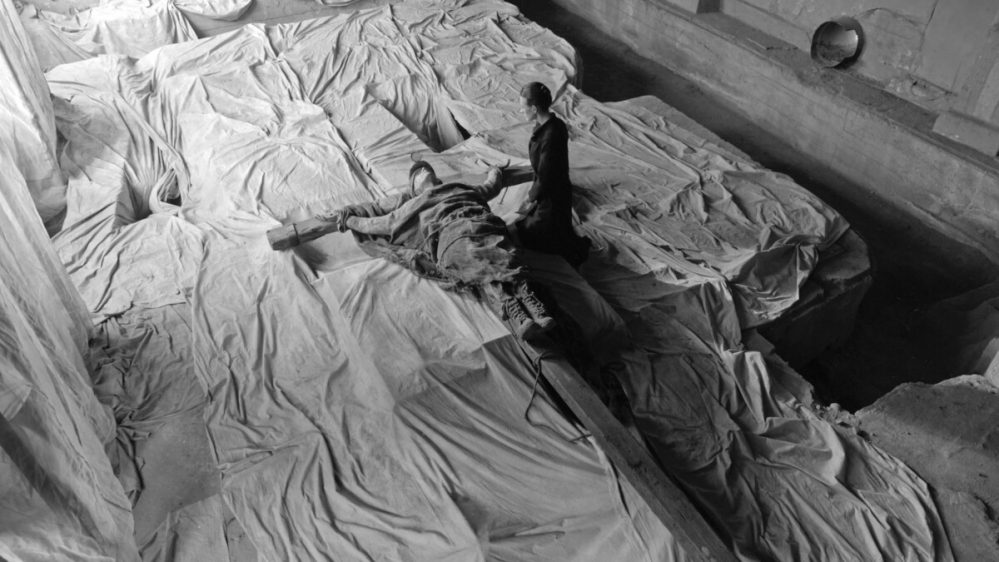
There is an old joke about a pious man stranded on a desert island. As he prays for divine deliverance, a ship arrives, but he sends it away, saying, “God will save me.” Ditto a helicopter and eventually a seaplane. The man dies, to his surprise, and when he gets to heaven, asks God why he did not save him. God replies, “Look, man, I sent a ship, a helicopter and a seaplane…” If the moral of this old chestnut were hewn from the craggy quarries of a benighted Georgian mining village, and carved in strikingly gorgeous black-and-white cinematography, it might look a little like “Citizen Saint,” Tinatin Kajrishvili’s somber, scabrous third film, in which a rural community refuses to accept a God who moves in anything but the most mysterious ways.
Departing from the low-key naturalism of her two prior features “Brides” and “Horizon,” here Kajrishvili moves into an overtly allegorical register, with Krum Rodriguez’s exceptional lensing bringing dystopian grandeur to the scrubby plains and rocky terrains of the remote Georgian countryside. The hillsides in this region are scarred with pit openings and dotted with rusting bulldozers, and there’s even a weatherbeaten iron monorail that delivers granite-faced workers deep into the bowels of the local mine. In a clearing on a Calvary-esque crag, there also stands silhouetted a rough-hewn wooden cross, on which the cruciform figure is that of a miner, in helmet and overalls. He is the local saint, watching over the town through petrified goggles, and each morning workers and villagers alike line up to troop around his feet and leave offerings.
Above ground, the images are reminiscent of Bela Tarr or the particularly dolorous stretches of early Tarkovsky movies, an impression accented by the strange siren-like blares, twangs and choral interludes of Tako Zhordania’s otherwordly score. Underground, the images are even more stark, recalling the more apocalyptically nightmarish passages of David Lynch’s “Twin Peaks: The Return.” In a dead-end section of the mine illuminated only by the cold flicker of a fizzing neon sign, old man Berdo (Levan Berikashvili) ekes out a meager existence, muttering to the ghost of his son who died ten years prior in a mine collapse. It is a disaster for which it feels like the whole community is still in mourning, particularly Berdo’s black-clad wife (Lia Abuladze), whom Berdo can no longer bring himself to face.
The statue is brought down for restoration at the local museum, a process overseen by Mari (Mari Kitia), whose own attachment to the saint seems somewhat less than pure — obscurely linked to the unhappiness of her marriage to Vano (George Bochorishvili), who lost his legs in the same pit accident. But when the following day Mari returns to the museum, accompanied by the officious mine owner (Temiko Tchitchinadze) and a local busybody (Gia Burdjanadze), the statue has vanished from inside the locked room. At the same time, a mute stranger (George Babluani, “Dede”) shows up, sprouting stigmata. It does not take long for the townsfolk to realize he is their saint made flesh, their very own municipal Messiah.
But the wonder he evokes, answering prayers left and right — one whisperish, hallucinatory sequence sees him reunite Berdo with his son and the other lost miners — quickly gives way to an infectious paranoia amongst a population all too aware that over the years they have confessed all their darkest secrets to the statue. The saint becomes a kind of timebomb walking among them, and so the move towards tragedy and self-defeat scarcely comes as a surprise. Indeed Kajrishvili and Basa Janikashvili’s screenplay is light on surprises overall, establishing such a pervasively dour mood from the outset that the inevitable ending does not land with the ironic bite that it could.
This is barely a criticism except in the context of new Georgian cinema which — from Dea Kulumbegashvili’s bleakly brilliant “Beginning” to Alexander Koberidze’s wonderful, whimsical “What Do We See When We Look At The Sky” to even the smaller-scale charms of last year’s Karlovy Vary-awarded “A Room of My Own” — has earned a reputation for unpredictability. With its painterly compositions and deliberate pacing, “Citizen Saint” belongs to a more classical arthouse tradition, which sardonically observes, and tacitly judges, its characters’ foibles and failings, rather than participating in them.
That makes the film a droll, distancing experience that can come off as faintly condescending in its view of the religious impulse as inherently petty and hypocritical, the last refuge of small-minded folk who cleave to the symbols and rituals of faith but reject their actual meaning. The agenda is intended as subversive, but a non-interventionist God, if one exists, would be rather gratified by “Citizen Saint”: Humanity, at least this desperate, grimy segment of it, hardly deserves God’s grace if this is what they do when they get it.











